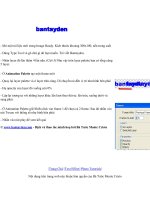Tài liệu Production and Cost Analysis I doc
Bạn đang xem bản rút gọn của tài liệu. Xem và tải ngay bản đầy đủ của tài liệu tại đây (455.22 KB, 62 trang )
© 2003 McGraw-Hill Ryerson Limited.
Production and Cost
Production and Cost
Analysis I
Analysis I
Chapter 9
Chapter 9
© 2003 McGraw-Hill Ryerson Limited
9 - 2
Introduction
Introduction
In the supply process, people first offer
the factors of production they control to
the market.
Then the factors are transformed by firms into goods that
consumers want.
Production occurs when factors of production (inputs) transform
into goods and services.
© 2003 McGraw-Hill Ryerson Limited
9 - 3
The Role of the Firm
The Role of the Firm
A firm is an economic institution that
transforms factors of production into
consumer goods and services.
© 2003 McGraw-Hill Ryerson Limited
9 - 4
The Role of the Firm
The Role of the Firm
A firm:
Organizes factors of production.
Produces goods and services.
Sells produced goods to individuals,
businesses or government.
© 2003 McGraw-Hill Ryerson Limited
9 - 5
The Firm and the Market
The Firm and the Market
A firm operates within the market and,
simultaneously, it abandons the market
in the sense that it replaces the market
with command and control.
© 2003 McGraw-Hill Ryerson Limited
9 - 6
The Firm and the Market
The Firm and the Market
How an economy operates depends on
transaction costs—costs of
undertaking trades through the market.
© 2003 McGraw-Hill Ryerson Limited
9 - 7
Firms Maximize Profit
Firms Maximize Profit
Firm’s goal is to maximize profit.
Profit is the difference between total
revenue and total cost.
Profit = Total revenue – Total cost
© 2003 McGraw-Hill Ryerson Limited
9 - 8
Firms Maximize Profit
Firms Maximize Profit
An accountant will calculate profit by
subtracting explicit costs from the
revenue.
For an economist,the measure of profit
is revenues minus both implicit and
explicit costs.
© 2003 McGraw-Hill Ryerson Limited
9 - 9
Firms Maximize Profit
Firms Maximize Profit
Implicit costs include the opportunity
costs of the factors of production.
Economic profit = Revenue – (Implicit
costs +Explicit costs)
© 2003 McGraw-Hill Ryerson Limited
9 - 10
The Production Process
The Production Process
The production process is generally
divided into a long run planning decision
and the short run adjustment decision.
© 2003 McGraw-Hill Ryerson Limited
9 - 11
The Long Run and the Short
The Long Run and the Short
Run
Run
A long-run decision is a decision in
which the firm can choose the least
expensive method of producing from
among all possible production
techniques.
© 2003 McGraw-Hill Ryerson Limited
9 - 12
The Long Run and the Short
The Long Run and the Short
Run
Run
A short-run decision is one in which
the firm is constrained by past choices
in regard to what production decisions it
can make.
© 2003 McGraw-Hill Ryerson Limited
9 - 13
The Long Run and the Short
The Long Run and the Short
Run
Run
The terms long run and short run do not
necessarily refer to specific periods of
time.
They refer to the degree of flexibility the
firm has in changing the level of output.
© 2003 McGraw-Hill Ryerson Limited
9 - 14
The Long Run and the Short
The Long Run and the Short
Run
Run
In the long run:
By definition, the firm can vary the inputs as
much as it wants.
All inputs are variable.
© 2003 McGraw-Hill Ryerson Limited
9 - 15
The Long Run and the Short
The Long Run and the Short
Run
Run
In the short run:
Flexibility is limited.
Some factors of production cannot be changed.
Generally, the production facility (“the plant”) is fixed in the short
run.
© 2003 McGraw-Hill Ryerson Limited
9 - 16
Production Tables and
Production Tables and
Production Functions
Production Functions
How a firm combines factors of
production to produce consumer goods
can be presented in a production table.
A production table shows the output
resulting from various combinations of
factors of production or inputs.
© 2003 McGraw-Hill Ryerson Limited
9 - 17
Production Tables and
Production Tables and
Production Functions
Production Functions
Most of the production decisions firms
make are short run decisions involving
changes in output at a given production
facility.
The firm can increase or decrease
production by adjusting the amount of
variable inputs, such as labour or
materials.
© 2003 McGraw-Hill Ryerson Limited
9 - 18
Production Tables and
Production Tables and
Production Functions
Production Functions
Total product is the number of units of
the good or service produced by a
different number of workers.
© 2003 McGraw-Hill Ryerson Limited
9 - 19
Production Tables and
Production Tables and
Production Functions
Production Functions
Marginal product is the additional
output that will result from an additional
worker, other inputs remaining constant.
Average product is calculated by
dividing total output by the number of
workers who produced it.
© 2003 McGraw-Hill Ryerson Limited
9 - 20
Production Tables and
Production Tables and
Production Functions
Production Functions
The information in a production table is
often summarized in a production
function – a curve that describes the
relationship between the inputs (factors
of production) and outputs.
© 2003 McGraw-Hill Ryerson Limited
9 - 21
Production Tables and
Production Tables and
Production Functions
Production Functions
The production function discloses the
maximum amount of output that can be
derived from a given number of inputs.
© 2003 McGraw-Hill Ryerson Limited
9 - 22
A Production Table,
A Production Table,
Figure 9-1a, p 203
Figure 9-1a, p 203
Number of
workers
Total
output
Marginal
product
Average
product
Increasing
marginal
productivity
Diminishing
marginal
productivity
Diminishing
absolute
productivity
4
6
7
6
5
3
1
0
2
5
1
2
3
4
5
6
7
8
9
10
0
4
5
5.7
5.8
5.6
5.2
4.6
4.0
3.3
2.5
—
4
10
17
23
28
31
32
32
30
25
0
© 2003 McGraw-Hill Ryerson Limited
9 - 23
Output
Diminishing
marginal
productivity
Diminishing
absolute
productivity
32
30
28
26
24
22
20
18
16
14
12
10
8
6
4
2
0
1 2 3 4 5 6 7 8 9 10
Increasing
marginal
productivity
Number of workers
TP
Output per worker
1 2 3 4 5 6 7 8 9 10
Number of workers
7
6
5
4
3
2
1
0
MP
Diminishing
marginal
productivity
Diminishing
absolute
productivity
(a) Total product (b) Marginal and average product
AP
A Production Function,
A Production Function,
Figure 9-1b
Figure 9-1b
and c, p 203
and c, p 203
© 2003 McGraw-Hill Ryerson Limited
9 - 24
The Law of Diminishing
The Law of Diminishing
Marginal Productivity
Marginal Productivity
The law of diminishing marginal
productivity is an important element in
all real-world production processes.
Both marginal and average
productivities initially increase, but
eventually they both decrease.
© 2003 McGraw-Hill Ryerson Limited
9 - 25
The Law of Diminishing
The Law of Diminishing
Marginal Productivity
Marginal Productivity
This means that initially the production
function exhibits increasing marginal
productivity.
Then it exhibits diminishing marginal productivity.
Eventually, the production function exhibits negative
marginal productivity.









